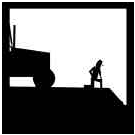Each
year many people die or are seriously injured in farm and
ranch accidents. Most of these accidents are preventable.
This checklist can be a guideline for farm and ranch operations
in evaluating each particular circumstance. Unsafe acts or
conditions, faulty equipment, or human error often cause accidents
that may result in injury, death, or property damage.
An inspection of your workplace will help prevent injuries
by identifying hazards, recording them, and taking corrective
action. You must be committed to correcting the hazards in
some manner if you are to succeed in reducing accident potential.
Aspects of Workplace Inspection
 Your
inspection should not be taken lightly. You may need several
family members or workers, or an outside set of eyes to see
some hazards that you may pass every day. No work area can
be 100 percent free of hazards. Include the questions "Who,
What, Where, When, and How" for each area examined.
Your
inspection should not be taken lightly. You may need several
family members or workers, or an outside set of eyes to see
some hazards that you may pass every day. No work area can
be 100 percent free of hazards. Include the questions "Who,
What, Where, When, and How" for each area examined.
When to Inspect
Many locations on a farm or ranch can be inspected year round.
The home buildings and other structures are examples of this.
Machinery and equipment can best be inspected when gearing
up for work in early spring, or in operation. Static inspection
examines the machine itself (shields and guards, decals, wear
and tear on parts), while an inspection during equipment operation
looks at unsafe acts of the operator or hazards in the field.
How to Compete the Inspection
As you go through the various sections of the following inspection
checklist, answer the questions or statements by checking
"Yes" or "No". If you have answered "Yes", no action is required.
If you have answered "No", then a hazard exists requiring
corrective action. You should then determine a priority level
for the hazard to indicate the urgency of the corrective action:
Priority level You should determine a priority level for
the hazard to indicate the urgency of the corrective action:
Written
by Tom Karsky, University of Idaho, and A. K. Jaussi, former
graduate assistant, Washington State University. For more information
about farm safety, please contact:
| Published December 1998 | Hand Signals | Farm Safety Series PNW 512 |
Disclaimer and Reproduction Information: Information in NASD does not represent NIOSH policy. Information included in NASD appears by permission of the author and/or copyright holder. More